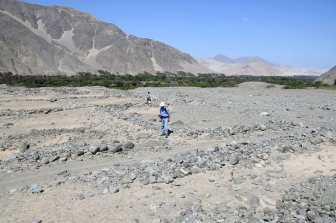
This past Sunday, my colleague Gustavo Valencia Tello, invited me to a Father’s Day lunch at his home in Casma, Peru. I am spending a couple of months in the area this summer as part of a co-creative project organized through Culture and Community in Casma (see this newsletter for more details). During our lunch, Professor Valencia and I had a wide ranging discussion not just about this summer’s work but also our collaboration that began in July of 2015. After finishing our meal Professor Valencia raised a question that got me to thinking. He asked:
“You are from a major university in the United States. In Casma we do not have a university and in Nivín we only have a very small school. Why do you keep coming back to Nivín?
At first, I was not certain how to respond. I thought about how the project is interesting. I thought about how the project is the most “co-creative” in which I have ever been involved in addressing community needs in a collaborative manner. But I realized those responses were really after the fact reasons. After a few seconds of thought, I replied:
“Because you asked us to come.”
We then discussed how one year before our first visit, my colleague Elizabeth Cruzado Carranza and Professor Valencia had communicated on Facebook where he had invited us to come to the small school museum. (I posted here about that first visit.) I recalled how when we first arrived in Nivín, after touring the museum, school grounds, and the surrounding archaeological sites, we asked Professor Valencia what we could do to help his project. He responded with a shopping list of needs. At the top of the list was museum management texts in Spanish. (Here is a link to our Annual Report for 2016 that details our completed projects to date.)
We are currently working with the school and community of Nivín to develop a five-year strategic plan that will guide our co-creative work in the future. Gustavo’s original invitation for Elizabeth and I to visit Nivín has led to very meaningful professional projects for all of us.
The “why did you come” question this past Sunday got me to thinking more. I thought about my first trip to Peru in the summer of 2013. That visit was also based on a request for me to come to help start a small museum and cultural heritage center in the village of Hualcayán to supplement archaeological research in that community. I learned much over the four years I spent on projects in Hualcayán.

I then thought about other times when I had just shown up after being asked over the years. I thought about my time as the Station Archaeologist at the Poverty Point World Heritage Site some 15 – 20 years ago. I often received requests from schools and libraries in Louisiana and Mississippi to just come and visit. One of the most rewarding requests was when I said yes to Debbie Buco, an elementary school teacher in Baton Rouge (described in this post).
Over the length of my career, without question, the most meaningful professional experiences have always come when I said “yes” to requests to be of service – often after a great deal of initial reluctance on my part.
I fear that we are in a time when such requests for service too often go unheeded. I am surprised by the reluctance of emerging professionals to share their successful and not so successful experiences with others in form of blogs or public presentations when asked to do so. I remember how odd it sounded to me during my first field school in 1986 to hear someone with their BA in Anthropology fresh in hand announce as they visited our excavations that he would never again do archaeology for free. Years ago advisors cautioned me against engaging in service because publications and grants were the name of the game when seeking faculty tenure. Just recently, the editor of a major peer review journal lamented to me that it was hard to get younger professionals to agree to do peer reviews of articles submitted for publication.
I appreciate too that one cannot, and should not say yes to every request that comes along.
I don’t intend this as a holier than thou piece. In fact, saying “yes” to requests, whether peer review, sharing experiences, or in a variety of community service opportunities, is really quite self-serving from the “in giving, you receive” perspective. The simple fact is that by saying “yes” to Professor Valencia a couple of years ago, my colleague Elizabeth and I each have at least another five-year project that will likely prove the most meaningful in both of our careers – Elizabeth as she works to complete her doctoral studies and for me as a post retirement project till I turn 70! Without question, those aspects of my career that I consider the most significant and meaningful would not have occurred had I not said “yes” to being of service.











